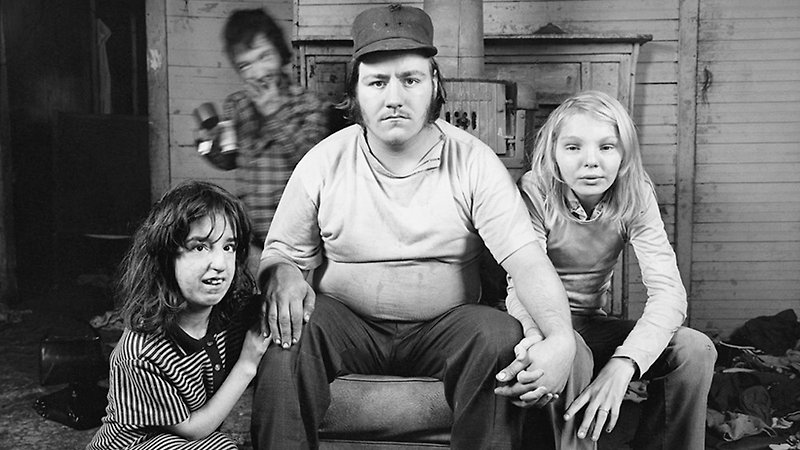
Screened as part of NZIFF 2003
The True Meaning of Pictures: Shelby Lee Adams' Appalachia 2002
Shelby Lee Adams’ photographs of Appalachian mountain families have brought him much success. (Google.com will take you straight to several galleries of his work.) However, his highly aestheticised, technically superb, portraits of poor mountain families are seen by many critics as exploitative and stereotypical: exhibits from the hillbilly freak show. Having grown up in the region himself, though in more privileged circumstances, Adams’ defense is that he is simply ‘trying to express myself with… my friends whom I love and care about’. Jennifer Baichwal’s stimulating, rigorously inquisitive film doesn’t plump for either point of view any more than it suggests that a picture can possess a ‘true meaning’. She interviews Adams’ opponents and supporters from the art world – and from the world of the photographs, including several of his subjects. Adams takes her on a shoot and lets her see how he works. The film begins with a series of the photographs – and presents the same pictures again at the end. No matter what you decide about Adams’ ethics, you can expect to see those photographs differently the second time round. — BG
Shelby Lee Adams takes photographs of Appalachian ‘mountain people’. He is extremely rare, if not unique, among documentary photographers because he works with only one community, and has been doing so for over thirty years. Adams was born and raised in the Appalachian mountains, although he was and is of a different class than his subjects. Adams’ subjects almost unanimously support his work, and assent to it to such an extent that he has been able to continue his photography for three decades. Yet his work generates extreme levels of controversy, both in Kentucky and outside it. Historically, Appalchian people have been labelled and maligned by mainstream America: as ‘trash’, poor, lazy, dirty, xenophobic, inbred, stupid and mean. There are numerous cultural artifacts of caricature: Deliverance, L’il Abner, The Dukes of Hazzard, The Beverly Hillbillies, etc. The US Government’s ‘War on Poverty’ in the 60s unleashed a media flood which painted a sensationalistic portrait of extreme and unrelenting squalor. In the face of what has come before, many people see Adams’ photographs as reinforcing and exacerbating the stereotype. He is accused of exploiting his subjects using various questionable techniques (lighting, flash, wide angle lenses) to distort and theatricalize them, and of presenting his work as documentary when it is not.
Adams claims that he is showing things as they really are and that his work is also a form of self portrait, and does not see any contradiction in asserting both simultaneously. He argues that people in America are ashamed of the fact that there are people living in abject poverty in a state which is rich in natural resources but has been stripped of them by speculators who through various corrupt practices made a great deal of money but gave nothing back to the community. Many of his subjects live without electricity or running water, in environments which have been devastated by coal mining practices, strip mining foremost among them. He claims that the new middle class of Kentucky are ashamed of this heritage of poverty and express their shame by denying its existence.
Adams also claims that his work is a form of exploring his own psyche and his own past growing up in the mountains. He says that his best pictures are a combination of this self-exploration and an authentic document of the people he photographs. This feature-length film seeks to unravel Adams’ problematic stance and to examine both the history of representation in the region and the current attitude towards it…
There is an inevitable voyeuristic experience for the viewer with documentary photographs, and the film spends time with a number of subjects in order to counter this. It is a truism that when you get to know someone, it is much more difficult to objectify or caricature them, but in this case I think it’s a crucial journey.
There are a few reasons why I felt compelled to make The True Meaning of Pictures. First, Appalachian people are marginal by circumstance but also by choice, rejecting the mores and values of dominant American culture. American culture is so monolithic around the world that to find an enclave in the country itself which remains sceptical is extraordinary, and for some reason I am drawn to subjects (eg Paul Bowles) who in one form or another reject it. Second, although being an outsider is always problematic, that status can sometimes make for greater clarity. There is, I have learned; a great deal of political baggage attached to Appalachia in the US. Although being familiar with the issues is crucial, being too familiar with them can engender a kind of blindness. Hopefully I can see through some of the rhetoric, because I have not grown up saturated by it. — Jennifer Baichwal